NCERT Exemplar for Class 11 Biology PDF On Vedantu
Vedantu provides NCERT books and other Biology study material that are updated with the latest syllabus. To prepare for the Biology Class 11 exam, you need to be well versed with all concepts in the subject. You will face many different questions from all sections of the subject, so you need to cover the entire syllabus thoroughly. You need to prepare all the topics from scratch, and the study material at Vedantu will help you prepare.
The best way to begin your preparation is to concentrate on perfecting and strengthening your concentration on basics. It is essential to get your basics right. Before you dive into difficult concepts, it is the basics that will help you glide through them. You can use the study material that we provide for the Class 11 Biology exam, to help you thoroughly work on your understanding of the subject. You must have a good knowledge of Biology, and it’s good to focus on the topics that are discussed in the test.
The NCERT Biology book contains all the topics that you need to study before the exam. The hope is that our content will be beneficial for you and help secure high marks in the exam. As a professional in the field of education for so many years, we have served many students and their growing needs for study material. We ensure our material is of the best quality possible to truly help students.
We not only provide all the NCERT books and study material, but we also guide through the process for students at all stages. All the study material will be correctly provided to you, so you need to follow our guidance, and you will get all the high-quality content. There are so many Biology books in the market, and it’s really hard to choose the best one. The first thing is to start your study as soon as possible, as you don’t want to miss any section of the syllabus for the final exams. We have also got many questions and study material, so don't worry about that.
Free PDF download of NCERT Exemplar for Class 11 Biology Chapter 10 - Cell Cycle and Cell Division solved by expert Biology teachers on Vedantu.com as per NCERT (CBSE) Book guidelines. All Chapter 10 - Cell Cycle and Cell Division exercise questions with solutions to help you to revise the complete syllabus and score more marks in your examinations.
Access ICSE Selina Solutions for Grade 11 Biology Chapter No. 10 - Cell cycle and Cell Division
Multiple Choice Questions(MCQs)
1. Meiosis in diploid organisms results in
a. Production of gametes
b. Reduction in the number of chromosomes
c. Introduction of variation
d. All of the above
Ans: (d) All of the above
Explanation: Meiosis results in reduction of the number of chromosomes and gametes are formed only after meiosis. Crossing over during meiosis leads to variations. Hence, all the options are correct.
2. At which stage of meiosis does the genetic constitution of gametes is finally decided
a. Metaphase I
b. Anaphase II
c. Metaphase II
d. Anaphase I
Ans: (d) Anaphase I
Explanation: In anaphase I of meiosis, each homologous chromosome with its two chromatids and undivided centromere; moves towards the opposite poles of the cell. Hence , the actual reduction occurs in this stage which decides the genetic constitution of gamete.
3. Meiosis occurs in organisms during
a. Sexual reproduction
b. Vegetative reproduction
c. Both sexual and vegetative reproduction
d. None of the above
Ans: (a) Sexual reproduction
Explanation: Meiosis is the reductional division that leads to production of gametes. It is not required during vegetative reproduction. Hence, option ‘a’ is the correct answer.
4. During anaphase-I of meiosis
a. Homologous chromosomes separate
b. Non-homologous autosomes separate
c. Sister chromatids separate
d. Non-sister chromatids separate
Ans: (a) Homologous chromosomes separate
Explanation: Homologous chromosomes separate during Anaphase I.
5. Mitosis is characterised by
a. Reduction division
b. Equal division
c. Both reduction and equal division
d. Pairing of homologous chromosomes
Ans: (b) Equal division
Explanation: There is no reduction in chromosome number during the mitosis hence it is also called an equational division that is required for growth & repairment of cells.
6. A bivalent of meiosis-I consists of
a. Two chromatids and one centromere
b. Two chromatids and two centromere
c. Four chromatids and two centromere
d. Four chromatids and four centromere
Ans: (c) Four chromatids and two centromere
Explanation: Bivalent is formed by pairing of two chromosomes. Thus, bivalent contains four chromatids and two centromeres.
7. Cells which are not dividing are likely to be at
a. \[{{\mathbf{G}}_1}\]
b. \[{{\mathbf{G}}_2}\]
c. \[{{\mathbf{G}}_0}\]
d. S phase
Ans: (c) \[{G_0}\]
Explanation: Phase \[{G_0}\] is also called quiescent phase and no cell division takes place during this phase.
8. Which of the events listed below is not observed during mitosis?
a. Chromatin condensation
b. Movement of centrioles to opposite poles
c. Appearance of chromosomes with two chromatids joined together at the centromere.
d. Crossing over
Ans: (d) Crossing over
Explanation: Crossing over takes place only during prophase I of meiosis.It is the exchange of genetic material between homologous chromosomes that results in mixing of parental characteristics.It occurs during meiosis.
9. Identify the wrong statement about meiosis
a. Pairing of homologous chromosomes
b. Four haploid cells are formed
c. At the end of meiosis the number of chromosomes are reduced to half
d. Two cycles of DNA replication occur
Ans: (d) Two cycles of DNA replication occur
Explanation: Since the number of chromosomes in daughter cells is going to become half, there is no need for an additional cycle of DNA replication.
10. Select the correct statement about \[{{\mathbf{G}}_1}\] phase
a. Cell is metabolically inactive
b. DNA in the cell does not replicate
c. It is not a phase of synthesis of macromolecules
d. Cell stops growing
Ans: (b) DNA in the cell does not replicate
Explanation: During \[{G_1}\] phase, the cell is metabolically active, continuously grows and carries out synthesis of macromolecules, but DNA synthesis does not take place during this phase.
VERY SHORT ANSWER TYPE QUESTIONS
1. Between a prokaryote and a eukaryote, which cell has a shorter cell division time?
Ans: Prokaryotic cells have a shorter cell division time.Bacteria tooks 30-60 mins to divide.
2. Which of the phases of the cell cycle is of longest duration?
Ans: Interphase of the cell cycle is of longest duration.Its time period is generally 18-20 hours.
3. Name a stain commonly used to colour chromosomes.
Ans: Acetocarmine and Giemsa stain.
4. Which tissue of animals and plants exhibits meiosis?
Ans: Germ cells of male and female reproductive organs in animals and plants exhibit meiosis.
5. Given that the average duplication time of E. coli is 20 minutes, how much time will two E. coli cells take to become 32 cells?
Ans: 1 hour 20 minutes required by the two E. coli cells to become 32 cells.
Number of cells after 20 minutes = 4 cells
Number of cells after 40 minutes = 8 cells
Number of cells after 60 minutes = 16 cells
Number of cells after 80 minutes = 32 cells
6. Which part of the human body should one use to demonstrate stages in mitosis?
Ans: Any part containing somatic cells can be used to demonstrate stages in mitosis in human beings.Germinal cells of human body divide by the meiosis.
7. What attributes does a chromatid require to be classified as a chromosome?
Ans: There should be two identical sister chromatids attached at centre by centromere; to be classified as a chromosome.
8. The diagram shows a bivalent at prophase-I of meiosis. Which of the four chromatids can cross over?
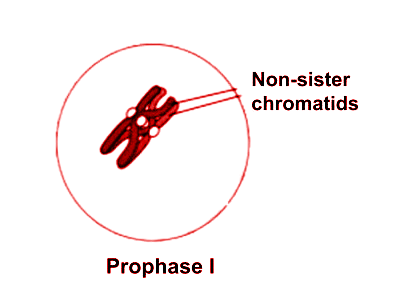
Ans: In this case, non-sister chromatids can cross over. It is important to remember that crossing over always takes place between two non-sister chromatids and never between two sister chromatids.
9. If a tissue has at a given time 1024 cells, how many cycles of mitosis had the original parental single cell undergone?
Ans: The product of each cycle of mitosis is 2 daughter cells. One can solve the above problem via the formula-: No. of daughter cells = 2no. of cycles. Hence , the cell must undergo 10 rounds of mitosis to produce 1024 cells.
10. An anther has 1200 pollen grains. How many pollen mother cells must have been there to produce them?
Ans: \[\dfrac{{1200}}{4} = 300\]
This is because one mother cell produces four daughter cells after meiosis.Hence , 300 pollen mother cells are required to produce 1200 pollen grains.
11. At what stage of cell cycle does DNA synthesis take place?
Ans: DNA synthesis takes place during the S phase of the cell cycle.
12. It is said that the one cycle of cell division in human cells (eukaryotic cells) takes 24 hours. Which phase of the cycle do you think occupies the maximum part of the cell cycle?
Ans: Interphase occupies the maximum part of the cell cycle.Its time period is generally 18-20 hours.
13. It is observed that heart cells do not exhibit cell division. Such cells do not divide further and exit_____ phase to enter an inactive stage called _____ of cell cycle. Fill in the blanks.
Ans: \[{G_1}\] phase, quiescent phase \[{G_0}\] .
14. In which phase of meiosis are the following formed? Choose the answers from hint points given below.
(a) Synaptonemal complex _____
(b) Recombination nodules _____
(c) Appearance/activation of _____ enzyme recombinase
(d) Termination of chiasmata ____
(e) Interkinesis ____
(f) Formation of dyad of cells _____
Hint-: |
1) Zygotene |
2) Pachytene |
3) Pachytene |
4) Diakinesis |
5) After Telophase-I /before Meiosis-II |
6. Telophase-I /After Meiosis-I |
Ans:
a. Zygotene
b. Pachytene
c. Telophase - I/After Meiosis – I
d. Diakinesis
e. After Telophase - I/before Meiosis – II
f. Pachytene
SHORT ANSWER TYPE QUESTIONS
1. State the role of centrioles other than spindle formation.
Ans: The role of centrioles other than spindle formation are-:
1. Formation of basal body of cilia and flagella.
2. Formation of microtubules.
3. Formation of sperm tail.
2. Mitochondria and plastids have their own DNA (genetic material). What is known about their fate during nuclear division like mitosis?
Ans: Extra-genomic DNA is found in mitochondria and plastids. It has nothing to do with the division of the nucleus during mitosis. As a result, extra-genomic DNAs are unaffected by karyokinesis during cell division.
3. Label the diagram and also determine the stage at which this structure is visible.
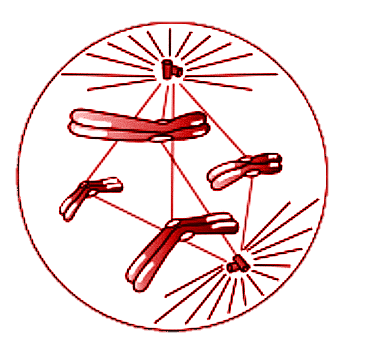
Ans: This figure shows the transition from prophase to metaphase during mitosis.
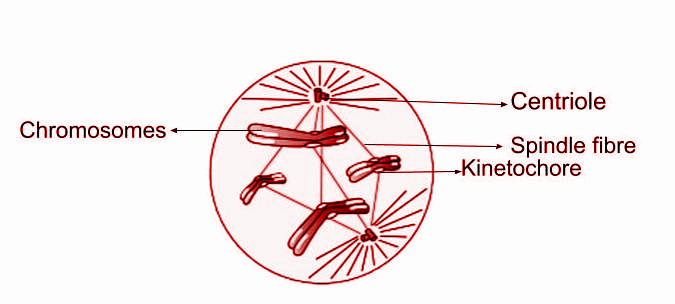
4. A cell has 32 chromosomes. It undergoes mitotic division. What will be the chromosome number (N) during metaphase? What would be the DNA content (C) during anaphase?
Ans: We know that DNA replication takes place during S phase and hence, the DNA content becomes double just after the S phase; and will remain so during the whole event of mitosis.
5. While examining the mitotic stage in a tissue, one finds some cells with 16 chromosomes and some with 32 chromosomes. What possible reasons could you assign to this difference in chromosome number? Do you think cells with 16 chromosomes could have arisen from cells with 32 chromosomes or vice versa?
Ans: Because of mosaicism, this can happen. Mosaicism refers to the coexistence of two populations of cells with different genotypes in a single person. Mosaicism can occur due to a variety of factors, including nondisjunction, anaphase lag, and endoreplication.
Mosaicism appears to be caused primarily by anaphase lag. The cells with 16 chromosomes must have developed from those with 32 chromosomes in this case.
6. The following events occur during the various phases of the cell cycle, Name the phase against each of the events.
a. Disintegration of nuclear membrane
b. Appearance of nucleolus
c. Division of centromere
d. Replication of DNA
Ans:
a. Disintegration of nuclear membrane occurs in prophase.
b. Appearance of nucleolus occurs in telophase.
c. Division of centromere occurs in anaphase.
d. Replication of DNA occurs in S-phase.
7. Mitosis results in producing two cells which are similar to each other. What would be the consequence if each of the following irregularities occur during mitosis?
a. Nuclear membrane fails to disintegrate
Ans: If the nuclear membrane fails to disintegrate, then the spindle fibres would not be able to reach chromosomes. Due to that, the chromosomes would not be able to reach the opposite poles of the cell.
b. Duplication of DNA does not occur
Ans: If DNA duplication does not take place, then the cell may not be able to reach the M phase. This will result in cessation of the cell cycle.
c. Centromeres do not divide
Ans: If division of centromeres does not take place, then one of the daughter cells will get a complete pair of chromosomes and another daughter cell will get none. This may result in trisomy. Trisomy is a type of abnormal number of chromosomes, i.e. aneuploidy.
d. Cytokinesis does not occur.
Ans: If cytokinesis does not occur, then a cell with a multinucleate condition would be formed.
8. Both unicellular and multicellular organisms undergo mitosis. What are the differences, if any, observed in the process between the two?
Ans: The differences are:
Mitosis in unicellular organisms | Mitosis in multicellular organisms |
1. The cell is directly divided into two parts. This type of cell division is known as amitosis | 1. Karyokinesis (division of nucleus) takes place before the division of cytoplasm (cytokinesis) |
2. Duplication of DNA content takes place simultaneously with the division of nucleus | 2. Duplication of DNA occurs in separate phase i.e. S phase. |
9. Name the pathological condition when uncontrolled cell division occurs.
Ans: The pathological condition that occurs due to uncontrolled cell division is called malignancy. The disease which happens because of malignancy is called cancer.
10. Two key events take place, during S phase in animal cells, DNA replication and duplication of centriole. In which parts of the cell do events occur?
Ans: DNA replication takes place in the nucleus. Duplication of centriole takes place in the cytoplasm.
11. Comment on the statement – Meiosis enables the conservation of specific chromosome number of each species even though the process per se, results in reduction of chromosome number.
Ans: Meiosis is called reduction division because the number of chromosomes in daughter cells becomes half of the number of chromosomes in mother cells. In spite of this, meiosis enables the conservation of specific chromosome numbers of each species. In fact, if there has been no meiosis, organisms would not have been able to evolve to sexual mode of reproduction. We know that fertilization involves fusion of male and female gametes.Hence,the zygote gets the chromosome pool from two cells and the number of chromosomes in a zygote becomes double that of the gametes. To maintain the specific no. of chromosomes after fertilization, it is necessary that the gametes should have half the number of chromosomes compared to what it is in somatic cells.
12. Name a cell that is found arrested in the diplotene stage for months and 1 years. Comment in 2-3 lines how it completes cell cycle?
Ans: This happens in mammalian oocytes. In female mammals, the egg formation begins while the female is still inside the womb. But meiosis gets arrested in the diplotene stage itself. This pause remains till the female attains sexual maturity. Once she enters the adolescence phase , meiosis gets resumed but this does not happen to all the oocytes. This happens in the phased manner because in each ovulation cycle; only a certain number of eggs are released by the ovary. For example; in human beings, only one egg is released roughly once in a month. The whole process continues till the cessation of reproductive capability in the female.
13. How does cytokinesis in plant cells differ from that in animal cells?
Ans: The difference between cytokinesis in plant cells and in animal cells are as follows:-
Cytokinesis in Plant Cell | Cytokinesis in Animal Cell |
i. Division of cytoplasm takes place by cell plate formation. | i. Division of cytoplasm takes place by formation of a cleavage furrow. |
ii. Cell plate formation begins at the centre and moves towards the periphery. | ii. Cleavage begins at the periphery and moves towards the centre. |
LONG ANSWER TYPE QUESTIONS
1. Comment on the statement — Telophase is the reverse of prophase.
Ans: Following contrasting features of prophase and telophase show that telophase is the reverse of prophase.
Prophase | Telophase |
i. Mitochondria, ER, Golgi Complex, etc. disappear. | i. Mitochondria, ER, Golgi Complex, etc. reappear. |
ii. Nuclear membrane disintegrates. | ii. Nuclear membrane gets reformed. |
iii. Chromosomes become clearly visible. | iii. Chromosomes lose their visible identity. |
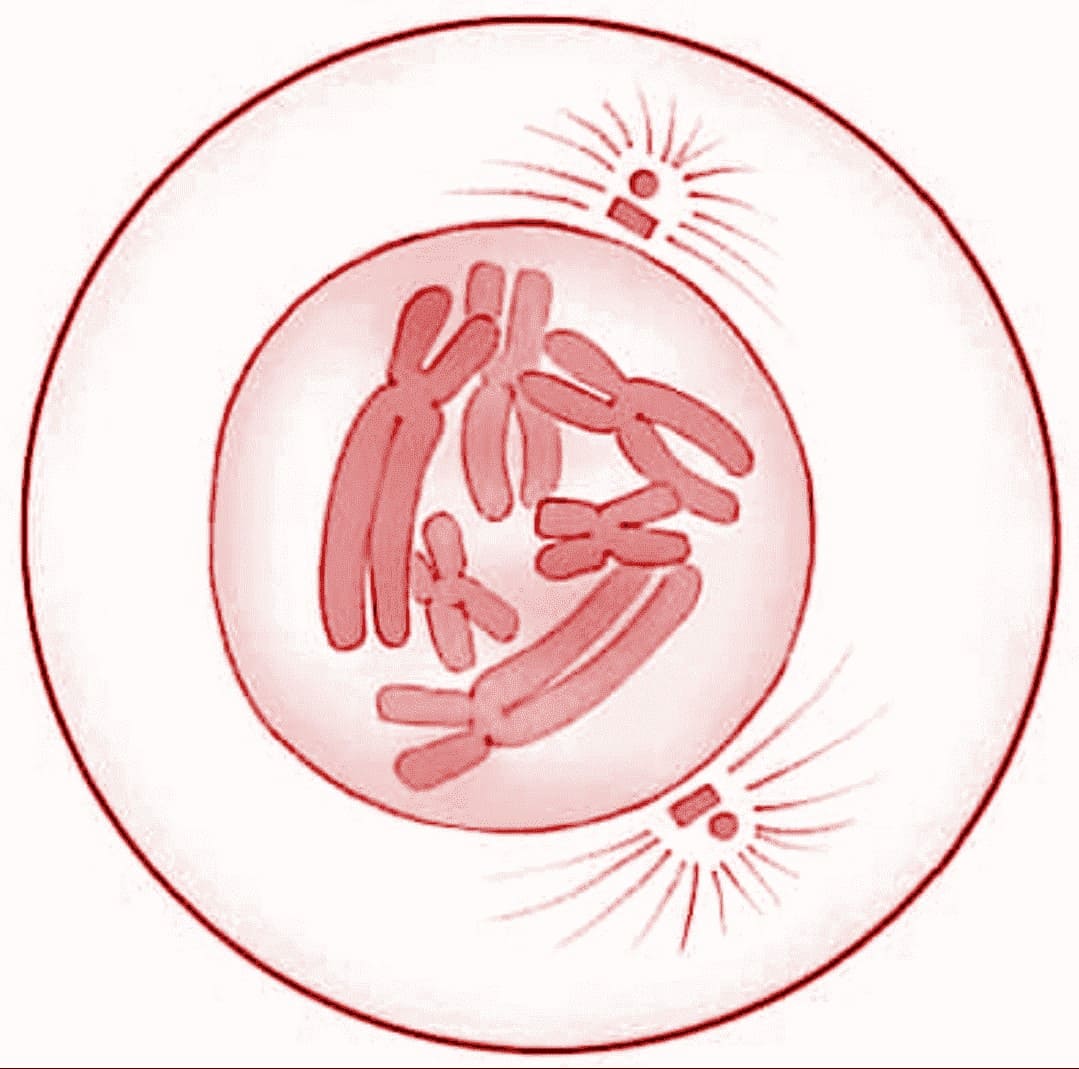
| 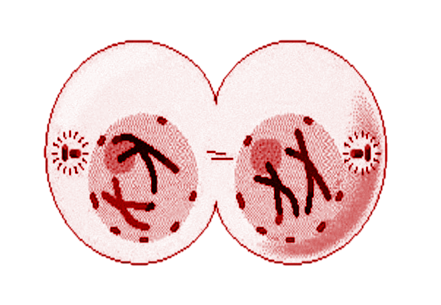
|
2. What are the various stages of meiotic prophase-I? Enumerate the chromosomal events during each stage?
Ans: Following are the various stages of meiotic prophase – I:
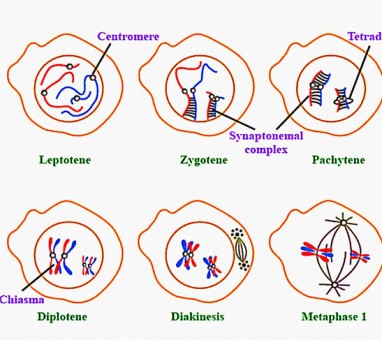
a. Leptotene: In this stage, chromosomes are visible clearly under the light microscope. The chromosomal compaction continues through this stage. The bound between the sister chromatids is so much that one cannot be differentiated from another.
b. Zygotene: During this stage , chromosomes start forming the pairs. This process is called synapsis. Formation of synapsis is accompanied by formation of synaptonemal complexes. Each & every pair is called a bivalent or the tetrad.
c. Pachytene: The bivalent chromosomes distincts & the recombination nodules(site at which crossing over takes place) appear on the tetrads.The process of crossing over takes place between non-sister chromatids of homologous chromosomes & it facilitates exchange of genes between them.
d. Diplotene: During this stage, the synaptonemal complex gets dissolved & the recombined chromosomes begin to separate from each other. But they remain attached at the site of crossing over. This makes an X-shaped structure that is termed as chiasmata.
e. Diakinesis: Chiasmata is terminated at this stage. Nucleolus as well as the nuclear membrane disappears.
3. Differentiate between the events of mitosis and meiosis.
Ans: The following are the differences between mitosis and meiosis:-
Events | Mitosis | Meiosis |
Prophase | The prophase lasts for a shorter period of time. At this point, the chromosomes are not distinguishable. Two distinct chromatids can be seen on chromosomes. During this stage, there is no crossing over. The prophase is straightforward and devoid of sub-stages. | Prophase–I is the longer of the two phases, while prophase–II is the shorter of the two. Chromosomes are distinct from one another. Prophase–I chromosomes do not have distinct chromatids. The chiasmata is formed, and the crossing over occurs. |
Metaphase | There is only one metaphasic plate. Chromosomes are self-contained and do not have any connections. The chromosomes' limbs are pointing in different directions. A chromosome's two chromatids are genetically identical. | During metaphase–I, two metaphasic plates form, but during metaphase–II, only one metaphasic plate forms. The chromosomes that are homologous are linked together. The chromosomes' limbs point to the centre. A chromosome's two chromatids are usually genetically distinct. |
Anaphase | Two centromeres are formed when a centromere splits along its length. Single-stranded chromosomes are found in all living organisms. Chromosomes that are similar move to opposite poles. | Centromeres do not divide during anaphase–I; however, centromere division occurs during anaphase–II. In anaphase–I, double-stranded chromosomes are present, but single-stranded chromosomes are present in anaphase–II. Dissimilar chromosomes move in opposite directions. |
Telophase | Telophase lasts a little longer. It causes interphase nuclei to form. | Telophase–I is the shortest phase. |
Cytokinesis | Every mitosis is followed by cytokinesis. At the end, two daughter cells are formed. | After meiosis–I, cytokinesis takes place, but not before meiosis–II. At the end of meiosis–II, there are four daughter cells. |
4. Write brief note on the following
a. Synaptonemal complex:
Ans: Protein makes up the synaptonemal complex. During meiosis, it is formed between two homologous chromosomes. Pairing, synapsis, and recombination all take place here. The homologous chromosomes are paired through the synaptonemal complex during prophase–I of meiosis. This complex facilitates the exchange of genes. Synaptonemal complexes play a role in the recombination of genetic characters.
b. Metaphase plate:
Ans: Metaphase plate is an imaginary line which is equidistant from the two centrosome poles. During metaphase, the chromosomes assemble at the metaphase plate. The even alignment of chromosomes is due to the opposing kinetochore microtubules.
5. Write briefly the significance of mitosis and meiosis in multicellular organisms.
Ans:
Significance of Mitosis:
1. Mitosis facilitates development of single-cell zygote into a full-grown organism
2. It facilitates the repair of worn out or damaged tissues.
3. It facilitates the vegetative propagation in flowering plants.
4. It facilitates regeneration in some animals; like Planaria.
Significance of Meiosis:
1. Meiosis ensures that the number of chromosomes becomes diploid in gametes. This helps in ensuring conservation of specific chromosomal numbers in each species.
2. Meiosis facilitates genetic variability in populations & This is because of crossing over events that occur during prophase–I.
6. An organism has two pairs of chromosomes (i.e., chromosome number = 4). Diagrammatically represent the chromosomal arrangement during different phases of meiosis-II.
Ans: The following diagram shows different phases of meiosis—II of an organism which has two pairs of chromosomes.
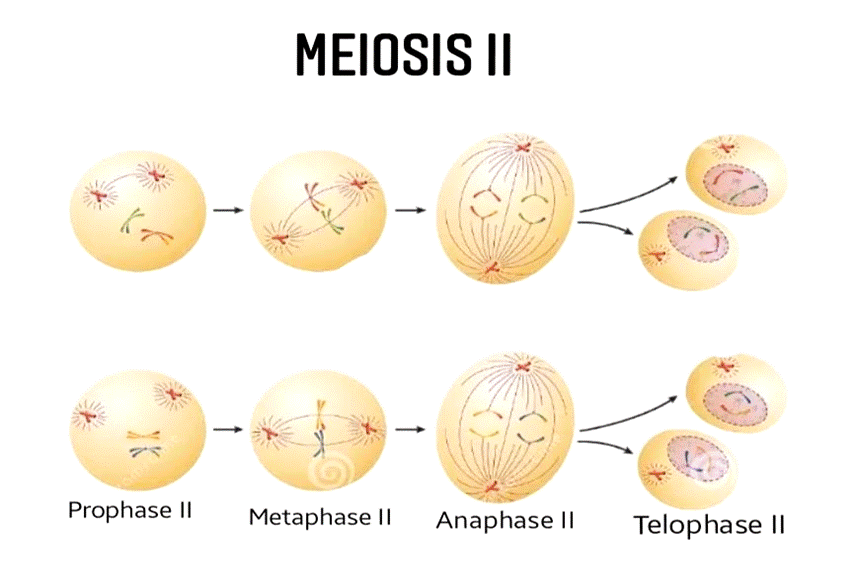
Here Are Some Important Concepts in the Chapter:
Cell Division
The cell division, a basic cellular function, is the process by which a unicellular eukaryotic cell gives birth to two identical daughter cells. During this process, a cell grows in size by the synthesis of cell organelles and membrane components. Then it divides into two similar cells which are called daughter cells. This process goes on until the cell contains the number of identical daughter cells. It goes about once a day. The division of a cell can be of three types.
Mitosis
This is a type of division, in which the cell undergoes a complete replication. Here, every nucleus is replicated again and again and the daughter cells are formed.
Cytokinesis
This type of division is only done when the cell reaches a specific size. In this type of division, the cell does not undergo a complete replication, but only replication of chromosomes. It’s an incomplete division.
Symmetric Type of Cell Division
Daughter cells are formed by a complete division of the parent cell. In this type of division, each nucleus divides to form two nuclei, which subsequently divide to form two daughter cells. In this type of division, the daughter cells that are formed are of unequal sizes. The daughter cells are formed as a consequence of partial or incomplete division.
Asymmetric Type of Cell Division
In mitosis, chromosomes are replicated in one nucleus and distributed into two daughter nuclei. The daughter nuclei then divide to form two daughter cells. During mitosis, the nucleus of the cell divides into two nuclei, and in between the two daughter nuclei, the nucleus can split into two daughter nuclei. During the first period of mitosis, daughter nuclei are formed at both sides of the nucleus, which is why it’s called prophase. The second period of mitosis is known as metaphase. Mitosis ends in the formation of daughter nuclei.
The cell in the image above contains four chromosomes. One nucleus has two centrioles. The other has one centriole. This kind of division produces two daughter cells, which have one nucleus each. During this process, the daughter nuclei divide into two daughter nuclei. This is an asymmetric type of cell division.
The cell contains 6 chromosomes. This kind of cell division results in the formation of three daughter cells, which have three nuclei each. During this process, each nucleus is split into three nuclei. This kind of division is called radial mitosis.
Asymmetric type of cell division occurs when mitosis divides the chromosomes into two daughter nuclei. The chromosomes in the two daughter nuclei are of unequal sizes. This division results in two daughter cells, each of which contains one nucleus. This is an asymmetric type of cell division.
The cell above contains one chromosome and it divides into two daughter nuclei. The chromosome divides during anaphase. The daughter nuclei of the cell in the image above are slightly different in size. These cells undergo a type of asymmetric cell division.
The cell contains three chromosomes. One nucleus divides into two daughter nuclei. In the cell that contains three chromosomes, this is an asymmetric type of cell division.
The cell above contains four chromosomes. The cell contains four chromosomes, and it divides into two daughter nuclei. Asymmetric cell division is when one nucleus divides into two daughter nuclei. This type of cell division may occur in some stem cells.
FAQs on NCERT Exemplar for Class 11 Biology - Cell Cycle and Cell Division - Free PDF Download
1. Does the term ‘mitosis’ refer to anaphase only? Why does it not refer to cytokinesis as well?
This is a common question for students of Biology I. Mitosis refers to all of the phases of the cell cycle before DNA replication begins. It is a term used by biologists, not by scientists. Cytokinesis is a word used by scientists. It refers to a phase after mitosis where the cell becomes larger. It is part of the prophase or interphase of the cell cycle. Cells do not undergo cytokinesis every time they divide. In mitosis, the chromosomes condense to form what is known as the mitotic spindle. The nuclear membrane detaches from the cell and is discarded. The chromosomes are aligned by the spindle and then the mitotic spindle releases them to enter the mitosis phase of the next cell cycle.
2. What is the purpose of prophase in Class 11 Biology?
This is a question that is usually asked by students who study a course in Biology. Students assume that mitosis is a natural stage in the life cycle of cells and that it is the major reason why cells are so much smaller in size as compared to one another. This is wrong. In a cell cycle, the cells go through successive phases of rest and activity. Prophase, which is the first phase of mitosis, is the resting phase. Mitosis takes place when the cell returns to the active phase of the cell cycle.
3. How are anaphase described in the chapter cell cycle and cell division?
In anaphase, the duplicated chromosomes separate from each other. In telophase, the duplicated chromosomes come together and then replicate their DNA. The answer is both, depending upon what the specific question is. It could mean both the actual state of things at the time, or it could be a description of the outcome of the process. For example, if you asked, “What is the difference between anaphase and telophase?” It could mean, “Telophase is the end state of anaphase,” or, “Anaphase is the phase in which the two chromatids move to opposite poles and the chromatids separate,” or, “The duplication of the chromatids results in a telophase.”
4. How many stages are there in mitosis as per class 11 Biology?
There are four stages of mitosis. Prophase, which is the resting stage, and metaphase, ana/telophase and interphase are the active phases. Mitosis has a total of four stages, of which mitotic phase I has two phases. Phases II, III and IV have three phases each.
5. Where Can I download NCERT Exemplar for Class 11 Biology - Cell Cycle and Cell Division?
You can easily download Class 11 NCERT Biology from Vedantu. This is a textbook published by NCERT for Class 11 Science and is made easily available across different platforms of Vedantu for easy download in PDF format. The NCERT Exemplar Book contains sample questions and answers for the study material. Free access to study material available for free on Vedantu. Everything from the syllabus to the chapter wise solutions all can be downloaded in PDF format for free!



















